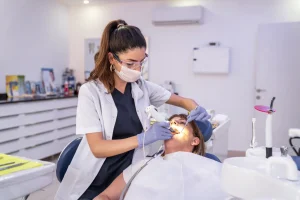Comprehensive Orthodontic Care from a Trusted North Edmonton Orthodontist
Understanding Orthodontic Treatment Options
Types of Orthodontic Appliances
Orthodontic treatments employ various appliances to correct misalignments in teeth and jaws. The most common types include:
- Braces: These are the traditional metal brackets that are bonded to the teeth and connected with wires. They are effective for treating a wide array of malocclusions.
- Ceramic Braces: Similar to metal braces but made from a translucent material, these blend more with the teeth and offer a more aesthetic appearance.
- Lingual Braces: These are attached to the back side of the teeth, making them invisible from the front, offering a discreet option for treatment.
- Invisalign: A popular alternative that uses a series of clear, removable aligners to gradually straighten teeth without the visibility of traditional braces.
Each type of appliance has its advantages and drawbacks, making it crucial for patients to discuss their options with their north edmonton orthodontist to determine the best fit for their needs.
Benefits of Early Orthodontic Evaluation
Early orthodontic evaluations are recommended for children as young as seven. The benefits include:
- Preventing future problems: Early assessments can identify issues that may develop into more severe problems later, allowing for timely intervention.
- Guiding the development of the jaw: Treatment at a young age can guide the growth of the jaw and teeth, leading to optimal outcomes.
- Reduced treatment time: Early intervention may lead to simpler treatments, including the potential for less severe braces or aligner use later on.
By addressing orthodontic concerns early, families can potentially save time and money while ensuring their children’s dental health and confidence.
Common Misconceptions About Orthodontics
Many myths circulate regarding orthodontics, contributing to reluctance in seeking treatment. These include:
- Orthodontics is only for children: While it’s beneficial for children, adults can also achieve desirable results and often have successful treatment experiences.
- Braces are the only option: With advancements in technology, options like Invisalign provide flexibility for those seeking alternatives.
- Orthodontic treatment is only cosmetic: Many treatments address functional issues, such as bite alignment, that can improve oral health and overall well-being.
Understanding these misconceptions is vital in overcoming barriers to seeking necessary orthodontic care. A consultation with a qualified orthodontist can clear up any confusion.
Choosing the Right North Edmonton Orthodontist
What to Look for in an Orthodontist
Choosing an orthodontist is a significant decision that can impact ongoing oral health. Key factors include:
- Qualifications: Verify their educational background, training, and certifications in orthodontics.
- Experience: An orthodontist’s experience with various cases can influence the effectiveness of treatment. Those with specialized practices may have better results in particular areas.
- Patient care and comfort: Office environment, staff demeanor, and the orthodontist’s approach to patient care should create a welcoming atmosphere.
- Technology and techniques: A practice that utilizes advanced technology and up-to-date techniques is likely to provide more efficient and effective treatment.
By considering these aspects, patients can identify an orthodontist that aligns with their needs and expectations.
Questions to Ask During Your Consultation
During an initial consultation, patients should feel empowered to ask questions. Some valuable inquiries include:
- What treatment options are best for my situation?
- What is the estimated timeline for treatment?
- What costs will I incur, and are payment plans available?
- How do you handle emergencies during treatment?
Asking these questions can empower patients to make informed decisions about their treatments.
Understanding the Provider’s Treatment Philosophy
Different orthodontists may have varied approaches to treatment. Understanding a provider’s philosophy is essential in ensuring alignment with patient expectations. A few key points to consider are:
- Holistic approaches: Some orthodontists may focus on an integrated approach that considers overall dental health, while others may prioritize aesthetic outcomes.
- Long-term care: Inquire about how they ensure ongoing care and maintenance after the initial treatment for sustained results.
- Involvement in community: Providers who engage with their communities often demonstrate commitment to patient care and awareness of ongoing advancements in orthodontic practices.
Patients should select an orthodontist whose treatment philosophy resonates with their values and dental health goals.
The Process of Orthodontic Treatment
Steps Involved in Getting Braces
The journey to a straighter smile typically involves the following steps:
- Initial Consultation: The orthodontist conducts a comprehensive evaluation, including X-rays and photographs, to create a personalized treatment plan.
- Placement: Braces or clear aligners are applied following the treatment plan, ensuring the correct positioning to achieve desired outcomes.
- Adjustments and Monitoring: Regular follow-up appointments allow the orthodontist to adjust appliances as needed and monitor progress.
- Completion: Once treatment is successful, retainers are prescribed to maintain the new position of the teeth.
Understanding each step demystifies the process and sets realistic expectations for patients embarking on orthodontic treatment.
Duration and Commitment Requirements
The timeline for orthodontic treatment varies based on individual needs. Factors influencing duration include:
- Severity of the case: More complex alignment issues may require longer treatment periods compared to simpler corrections.
- Type of appliance: Traditional braces may take longer than removable aligners, depending on the treatment plan.
- Patient compliance: Adhering to the orthodontist’s instructions and attending regular appointments significantly impacts treatment duration.
On average, treatments can range from several months to a few years, making patient commitment crucial for the best outcomes.
Aftercare and Maintenance of Dental Health
Post-orthodontic care is essential for maintaining results. Patients should consider:
- Use of retainers: Following treatment, wearing retainers as prescribed helps keep teeth in their new positions.
- Regular dental check-ups: These visits allow healthcare providers to monitor oral health and catch any issues early.
- Proper hygiene practices: Maintaining good oral hygiene is vital, as braces or aligners may create additional challenges in cleaning teeth effectively.
Proper aftercare ensures lasting results from orthodontic treatment.
Technology in Orthodontics
Digital Scanning and Imaging
Technological advancements, like digital scanning and imaging, have transformed orthodontic assessments. Benefits include:
- Precision: Digital scans provide detailed images of teeth and jaws, enhancing diagnosis and treatment planning accuracy.
- Patient comfort: Digital impressions are often more comfortable than traditional molds, reducing patient discomfort during assessment.
- Efficiency: The speed of digital imaging reduces the time spent in the office, allowing for quicker consultations and treatment plans.
Patients can benefit from these technological innovations that streamline their treatment journey.
Invisalign vs. Traditional Braces
Both Invisalign and traditional braces are effective methods for correcting malocclusions, yet they cater to different patient preferences:
- Invisalign: Offers a clear, removable alternative that is nearly undetectable. Patients can maintain their oral hygiene practices easily without the restrictions typically associated with braces.
- Traditional Braces: Known for their effectiveness in treating complex cases. They are fixed appliances, meaning patients do not have to remember to wear them consistently.
Patients should weigh the pros and cons of each method with their orthodontist to find the most suitable solution for their needs.
How Technology Enhances Treatment Effectiveness
Innovative technologies are continuously evolving, enhancing the effectiveness and reliability of orthodontic treatments. Advances can include:
- 3D printing: Used for creating models and aligners that fit precisely to a patient’s teeth, improving comfort and efficiency.
- Teleorthodontics: Provides remote consultations, allowing orthodontists to monitor progression and adjust treatment plans without always requiring in-person visits.
- AI technology: Some orthodontic practices are now utilizing AI for treatment planning, leading to more informed approaches and faster results.
With these advances, patients can experience more precise, effective treatments, which can lead to improved satisfaction with their orthodontic experiences.
Patient Testimonials and Success Stories
Real Experiences from North Edmonton Patients
Understanding the experiences of others can provide invaluable insights into the orthodontic process:
- Improved confidence: Many patients report increased self-esteem and confidence after completing their orthodontic treatments, positively impacting their social interactions and professional lives.
- Functional benefits: Beyond aesthetics, patients often share stories of improved oral function, such as better chewing and speaking abilities, following their treatments.
These testimonials highlight the psychological and functional benefits of orthodontic care.
Transformations Achieved Through Treatment
Visual success stories play a significant role in illustrating the transformation possible with orthodontic treatment. Case studies commonly show:
- Before and After Photos: These compelling images capture the dramatic changes in alignment and aesthetics over the course of treatment.
- Detailed treatment plans: Many orthodontists share cases that illustrate the step-by-step process, empowering potential patients with knowledge about expected outcomes and timelines.
Transformations through orthodontic treatment serve as inspiration for new patients embarking on their journeys.
The Importance of Continuing Care and Follow-Ups
Post-treatment follow-up visits are crucial for ensuring sustained success. Key takeaways include:
- Monitoring retention: Ongoing check-ups help monitor the position of teeth and the effectiveness of retainers in maintaining new alignments.
- Addressing any concerns: Follow-up appointments allow patients to address any concerns or questions regarding their treatment results.
- Long-term oral health: Continuing care ensures that overall dental health remains a priority, paving the way for a lifetime of beautiful smiles.
These aspects highlight the commitment required from both patients and orthodontists to achieve lasting results and optimal dental health.














Post Comment